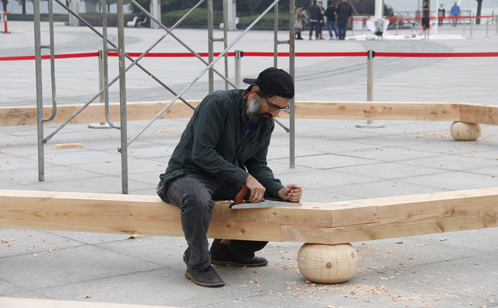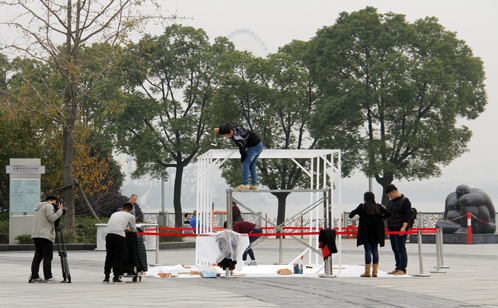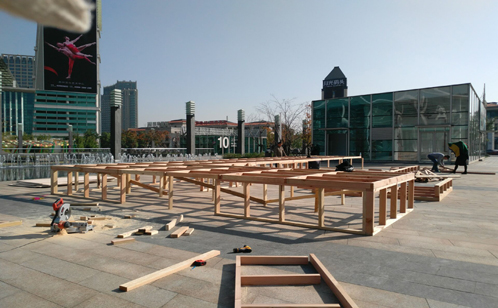An exhibition, The Idiorrhythmic: Canadian & Chinese artists Urban Art Creation Project, was staged on Nov 15, 2016 and will last till Dec 11, 2016 at Suzhou Industrial Park. The projects by Canadian and Chinese artists at the event alongside the Jinji Lake are believed to be the witnesses to the communication between China and Canada.

Addressing the opening ceremony, Yan Xiaojing, one of the curators of the exhibition, said, "he exhibition provides opportunities for Canadians and Chinese, artists and residents to learn about each other's cultures." As an artist who migrated from China to North America, Yan keeps looking for ways to promote communications between China and Canada. Both her identity and her work pass through the complex filters of different countries, languages, and cultural expectations. And this time she combined her ideas with the planning of the exhibition.
"Some famous Canadian artists are not widely known in China," Yan said. "Taking the Canada-China Year (2015-2016) as an opportunity, the exhibition aims to bring more Canadian artists to China and enable them to learn more about China."
The curators, together with other sponsors, spent more than 7 months planning the exhibition titled "Idiorrhythmic". That takes references of French thinker Roland Barthes's ideas on how different forms of life and practices can be entwined as a creative process. Yan said they wish to explore how different artistic processes, cultural practices and urban fabrics can be creatively implicated as a bundle of rhythmic entanglements.

A total of 13 artists, nine from Canada and four from China, are invited to the exhibition.
"We drove around in Suzhou, both the old and new, to get images," said Iain Baxter&, one of the Canadian artists at the exhibition.
His project named Reflections of & on Suzhou is made up with photos taken from the reflections in the mirror. The mirror has become one of the tools for the 80-year-old artist since 1960s. He said the way of looking at life reflections is important and mirror shows the reflection. This time, environment, families and activities in Suzhou were all recorded by reflective photos. He took hundreds of pictures in two weeks and 50 of them are on display at the exhibition.
"Old Suzhou is a symbol of traditional China while the new which is well developed and advanced, is for the younger generation,"said Iain, hoping someday he would have a chance to come back to Suzhou and hold exhibitions to show the images of Canada.

Not only the beautiful landscape of Suzhou impressed the Canadian artists, but also the traditional Chinese literature moved them as well. The six-sided pavilion with calligraphy is the project by Canadian artists Yvonne Lammerich and Ian Carr-Harris at the exhibition. Named as "Six Records of a Floating Life by Shen Fu: a Pavilion for Suzhou", it takes as its model the title of the famous Chinese book written by Shen Fu, a Suzhou native, in the Qing dynasty (1644-1912).
"I have read Six Records of a Floating Life several times. It was very easy to read and very touching,"said Yvonne Lammerich.
Six Records of a Floating Life tells romantic stories about the daily life of Shen Fu and his wife. For Yvonne Lammerich and Ian Carr-Harris who had never been to China before, the simple language and candid descriptions of the writer's observation in the book rendered them a better understanding of China and more about art.
Influenced by the power of art, Yvonne said, "Today, we can still enjoy Chinese history even though we are not from China." She said Shen Fu, as an artist, gave the readers a legacy in history of witnessing his own time. "This is the significance of what art can do over centuries. The book is a reminder of how powerful art can be,"she said.
All the exhibits involving sculpture, installation, intervention, performance and video projections were created on the spot within two weeks. The public space, where the exhibition is held, provides artists and residents with an opportunity to interact with each other. Many local residents watched and participated in the process.

"An elderly passerby once helped one of our Canadian artists, Mani Mazinani, cut woods," Yan said, "and they used body language to communicate because they could not understand each other due to language barrier."
The interaction between artists and local people promotes the understandings between Chinese and Canadians.
"The Canadian artists are so serious about their work,"the Chinese workers marveled after they saw the Canadian artist David Alexander unloading the materials from the truck in pouring rain.
"His shirt was totally wet, but he continued to remove woods from the truck nonstop in an effort to finish the project on time," Yan was moved as well.